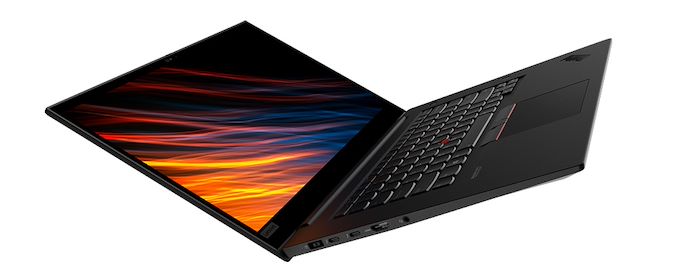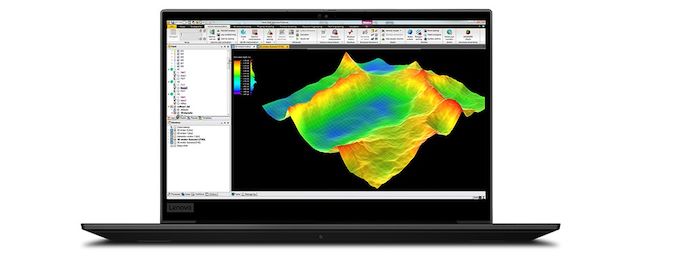Lenovo’s New ThinkPad P1 Gen3 for Professionals: OLED, 8-core Xeon, Quadro
by Dr. Ian Cutress on June 17, 2020 9:30 AM EST_678x452.jpg)
At the high-end of Lenovo’s ThinkPad designs, where professionals need server-grade features like ECC and graphics focused on compute or rendering, we get the P1 model which is updated for 2020 as the P1 Gen3. This notebook refresh is a 15.6-inch design, offering an OLED display, choice of Intel 10th Gen or Xeon processors, and Quadro-level graphics. The underlying design of the chassis is carbon fiber, aiming to be sturdy yet lightweight, with a fingerprint resistant finish to enhance the aesthetic of a premium system.
The ThinkPad P1 Gen3 is a 15.6-inch design with options that include a 3840x2160 OLED touch display at HDR500, a 3840x2160 LCD IPS variant up to 600 nits, or a 1920x1080 IPS 500nit HDR lower-cost option. Under the hood it supports Intel’s 10th Gen Core mobile 45 W processors, or their Xeon equivalents, which extends support to up to 64 GB of ECC for the Xeons via two SoDIMM slots. Graphics are available up to an NVIDIA Quadro T2000. There are two M.2 drives in the system, allowing for up to 4 TB of NVMe SSDs in RAID 0/1, and the system comes with an 80 Wh battery. Two power supplies are available – a base 135 W slim model or a 170 W slim model. Operating system options include Windows 10 Home, Pro, Pro for Workstations, Ubuntu, Red Hat (certified), or Fedora.
For professional users, the P1 Gen3 supports TPM, has a touch fingerprint reader for easy log-in, and a shutter mechanism for the 720p webcam. There is also an optional separate Hybrid IR camera. On the connectivity side, Intel’s AX201 Wi-Fi 6 solution is included as standard, but a CAT16 LTE smartphone modem is an optional extra, which comes in the M.2 form factor. The system is certified for a number of software vendors, such as AutoCAD, CATRIA, NX, SolidWorks, Revit, Creo, Inventor, etc.
From the design, the unit comes with the usual ThinkPad bells and whistles. The keyboard includes the TrackPoint in the middle of the keyboard, and the track pad at the bottom has physical keys above it. The keyboard is backlit and spill resistant. Ports on the side include two USB 3.2 Gen 1 Type-A ports, two USB-C Thunderbolt 3 ports, a HDMI 2.0 video output, a 3.5mm jack, and an SD Card Reader.
The P1 Gen3 comes with Lenovo’s ThinkShield software, and will also be the recipient of Lenovo’s new Ultra Performance Mode that allows the user to adjust the performance settings in order to achieve a desired performance or thermal characteristics of the system. Lenovo believes this is mostly relevant to users who need full turbo to get a project completed on time, or for those who use the system with VR and require a minimum standard of performance without any potential thermal disruptions.
The P1 Gen3 starting weight is 3.75 lbs (1.7 kg), which will add on with the addition of a graphics card / more memory / more storage etc. The Lenovo ThinkPad P1 Gen3 will be available from July, starting at $2019.





_carousel_thumb.jpg)
_carousel_thumb.jpg)
_carousel_thumb.jpg)
_thumb.jpg)








59 Comments
View All Comments
ahtoh - Wednesday, June 17, 2020 - link
afaik 1080p USB2 web cams send over compressed video, that requires encoding being performed on the cam side.Santoval - Thursday, June 18, 2020 - link
Only certain professional cameras (particularly those used for digital cinematography) and prosumer and higher DSLRs can record uncompressed video. A webcam does not, and does not need to record uncompressed video because it would make no sense at all.Tams80 - Friday, June 19, 2020 - link
The highest I've seen on USB 2.0 is 1080p30 but even that might have been compressed.1080p60 absolutely requires USB 3.0 or higher.
I think as others have mentioned, that it's down to:
a) getting rid of existing stock
b) most buyers just not caring enough/the webcams are good enough
c) video calling services don't stream at much higher than 720p anyway
d) the rest of the camera assembly isn't great, so there's no point in wasting a decent sensor on one
e) decent camera assemblies that will fit into a bezel (remember, these are thin) are going to be relatively expensive
olafgarten - Wednesday, June 17, 2020 - link
I can confirm that the camera on the X1E Gen 2 is trash, one of the worst parts of the laptop, it's even noticeably bad on a standard video chat.eastcoast_pete - Thursday, June 18, 2020 - link
Mostly because manufacturers can get away with it. I agree that a "professional" laptop (mobile workstations certainly qualify) should warrant the extra couple of dollars or Euros that a decent 1080p camera with integrated h264/VP9 compression. Video conferencing has become a daily occurrence for many of us, so it's no longer a luxury. Plus, some other "premium" laptops have quite decent built-in cams, so it can be done.yeeeeman - Wednesday, June 17, 2020 - link
Incoming "why it doesn't have Renoir" comments in 3....2....1....blomquist - Wednesday, June 17, 2020 - link
a legit question ;)ogremic - Wednesday, June 17, 2020 - link
but... why does it not have Treadripper? :Deastcoast_pete - Friday, June 19, 2020 - link
Because AMD hasn't gotten its act together in the premium mobile space. Now, to be fair, they are just back in the fast lane for about 2 years, so maybe they'll surprise us with a professional version of Renoir, maybe with 8, 10, 12 and 16 cores, ECC support and a generous helping of PCIe 4.0 lanes. Now, that would be a good reason to ask "why doesn't this have AMD inside?". Right now, mobile professional workstations are Intel's domain. I wouldn't spec a professional workstation without ECC RAM, if only to avoid the liability if anything goes wrong after "it worked so well in the simulation".WaWaThreeFIVbroS - Wednesday, June 17, 2020 - link
One day later and the ones mentioning the word "Renoir" is only you and meOh reality....